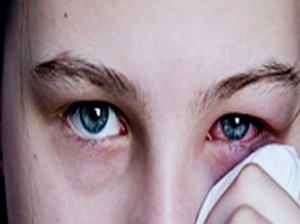Most of the time people ignore it when they get an itchy eye. As the saying goes, the eyes are the windows to the soul of an individual because they reflect what is on the mind. This cannot be true when the person gets swollen, watery, red and itchy eyes. Itchy eye usually happens due to an allergic reaction. When a person gets a common cold, the eyes oftentimes become watery and itchy. Severe irritation is an indication for the need to visit an ophthalmologist, allergist or an emergency room for immediate medical attention. When the situation is severe it can endanger the eyesight.
Itchy eye is commonly linked with other allergic illnesses particularly dermatitis or atopic eczema, or hay fever. The causes of itchy eye are similar to the triggers for the allergic reaction as well. Cosmetics and medications also contribute in causing irritation to the eye.
How Itchy Eye is Caused
When people open their eyes during the day, they are directly exposed to the outer world without any protection that helps to filter out foreign particles that cause irritation; unlike the nose which has hairs called cilia. Eye allergy involves the inside folds of the eyelids and the tissue lining that overlays the white area of the eyeball or the conjunctiva. The conjunctiva is the wall structure exposed to the outer environment and the various numbers of allergens which are substances that trigger allergy. This part of the eye is abundant in blood vessels and has more mast cells compared to the lungs. People who have inherited allergic diseases are more at risk to eye irritation and the very same people typically have histories of atopic dermatitis and allergic rhinitis. The symptoms commonly appear when one reaches the age before 30.
The allergens responsible for itchy eye cause the IgE, an allergy antibody to cloak many mast cells in the tissue lining of the outer eye. When it is exposed again to the allergen, these mast cells are triggered to release many mediators, including histamine. This results to irritated eyes manifested by watery, burning and itchy eyes, making them reddish due to inflammation followed by congestion afterwards. In some cases, the eyelids swell so much that they close or almost close. The conjunctiva may swell with lots of fluid and expand from the outer layer of the eye which makes it look like a hive on the eye. Usually eye allergy affects both the eyes. Sometimes, only one is affected especially with cases when one eye is rubbed off together with an allergen which prompts the mast cells to produce more histamine.
Itchy Eye Conditions
One of the common itchy eye conditions is known as the allergic rhinoconjunctivitis or allergic conjunctivitis. In most cases this eye allergy is linked with hay fever and is commonly seasonal. The main agents are the pollens, but indoor allergens may also be causes such as the molds, dust mites and the dander from various household pets like the cats and dogs. Usual complaints from patients suffering eye allergies include eyelid swelling, watery discharge, burning, tearing, redness and itching. The same thing holds true for severe degrees of allergies.
Another eye allergy condition is called atopic keratoconjunctivitis which is a notorious originator of the harsh eye changes particularly amongst the young adults. Also known as conjunctivitis with atopic dermatitis, this indicates inflammation of the cornea and the conjunctiva. The kerato in the term pertains to the cornea of the eye. This form of eye allergy commonly affects adolescent boys, who are three times more frequent suffer from the condition compared to adolescent girls. This is also common amongst those who experienced atopic dermatitis during their early childhood. This condition is identified by the intensity of the itchiness on red areas that emerge on the eyelid part. Heavy discharge may result from the eyes and the eyelids may show crusts and scales. In worst cases the eyes become painful when exposed to bright light and eyelids become noticeably thicken. If this condition is badly managed, permanent scarring may happen to the cornea which is a result from scratching and rubbing of the eyes. The scarring of the cornea can also affect visual changes.
Amongst the various conditions of eye allergy, vernal keratoconjunctivitis is the most uncommon one. It happens amongst pre-adolescent boys and commonly outgrown in the early adulthood or late teens. This condition commonly appears in late spring and specifically affects residents of rural areas that are exposed to warm, windy, dusty and dry environment. The eyes become fiercely itchy, irritable to light and the eyelids feel droopy and uncomfortable. A close examination of the eye will show that there is severe inflammation which is caused by the abundance of mast cells and the accumulated eosinophils.
Treatment for itchy eye varies depending on the condition the patient is experiencing and the cause. It is imperative that the right treatment is applied to the specific condition because when it is done improperly, visual impairment may ensue.
